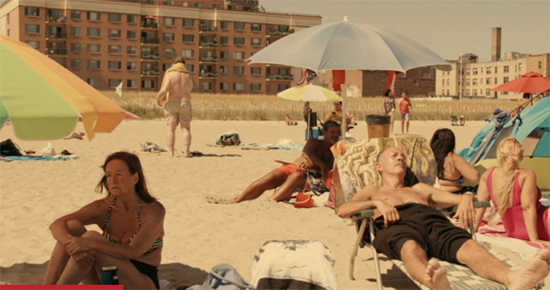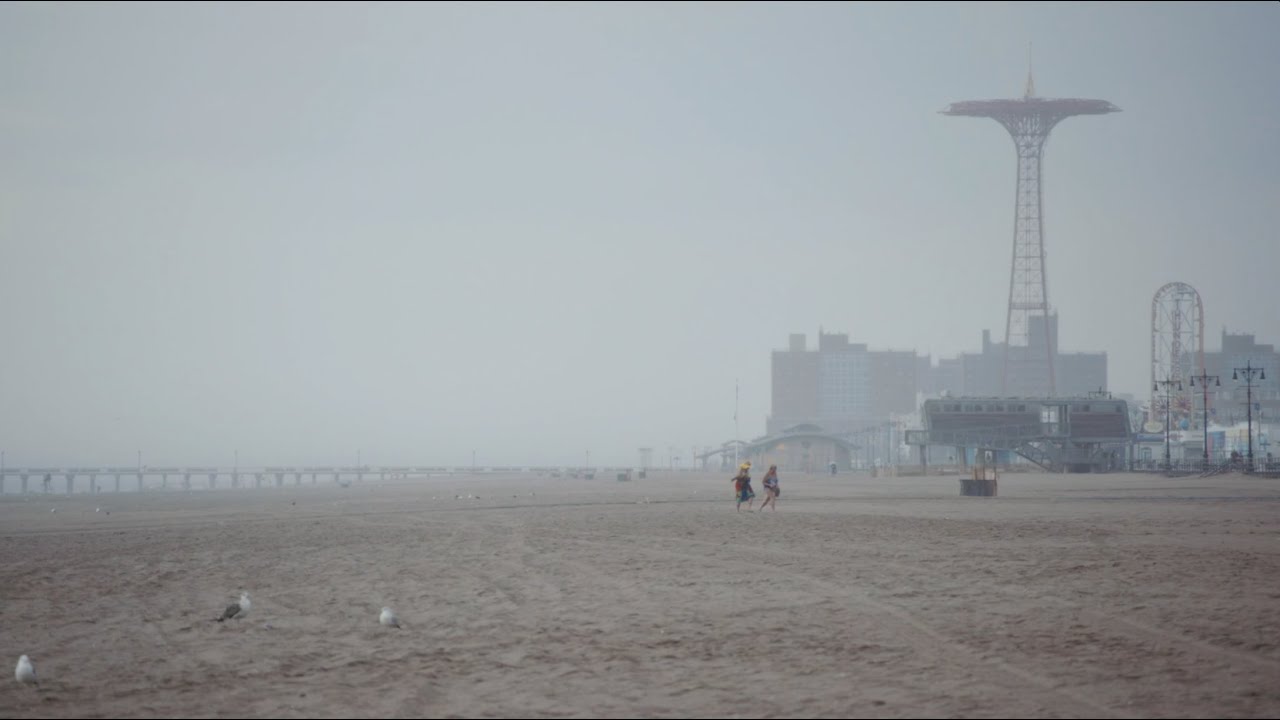Apparently it was so warm and wet this October that pumpkins in New York were rotting a week before Halloween. As a non-American, I don’t hold this holiday particularly close to my heart, but it’s still unsettling to watch the unravelling of the seasonal stability that underwrites so many cultural traditions. I watched The Hottest August in Australia, where massive fires, which usually only arrive with summer, devoured huge swathes of forest in the first weeks of spring. Anyone keeping an eye on the news is inundated with symptoms of the climate crisis, so it’s somewhat strange to watch a documentary ostensibly about the subject in which the phrase ‘climate change’ is only uttered once. Perhaps before entering the cinema I should have read the film’s tagline, which describes it as ‘A film about climate change, disguised as a portrait of collective anxiety’.
The basic premise: Over the summer of 2017, filmmaker Brett Story roamed New York conducting a series of vox pop interviews, hoping that in her footage ‘something useful might be gleaned about the time’. Add in wide shots of heat-hazy streets, a haunting soundtrack and lyrical voiceovers, and the result is Humans of New York filtered through Chris Marker’s Sans Soleil. Viewers meet amateur astronomers, retired real estate agents, call-centre workers and elderly couples dancing in the park. Story asks them about their hopes and fears, but not specifically about the climate, as far as we can tell. In their answers, themes of job insecurity, racism and gentrification reoccur; climate change is only mentioned in passing or by allusion.
A Hurricane Sandy survivor brushes off the possibility of another megastorm: ‘I don’t believe in that … that’s Al Gore. He’s making tons of money on all of that.’ A VR game designer enthusiastically describes the utopian vision of a fully automated economy fully-automated luxury communism, but is anxious that everything ‘might all be gone in five years’. A voiceover recites the city’s birth and death rates and reports how many tons of garbage are being collected, but there are none of the carbon emissions stats that support most climate-change documentaries. Again, only an associative reference: ‘while the city was home to many animals, thousands of the planet’s species had recently gone extinct.’
In The Uninhabitable Earth, David Wallace-Wells writes that at a time when the threat of climate change looms large, our movies ‘suffer from an incredible failure of imagination’. Mad Max: Fury Road, Children of Men, A Quiet Place – in none of these dystopian visions is global warming the main cause of collapse. Of course, these are all fictional; there have been lots of climate-change documentaries. But unlike The Hottest August, most have been fairly didactic affairs: the Powerpoint-presentation-as-film An Inconvenient Truth or general surveys of climate science and the clean energy sector such as Before the Flood. By focusing on the everyday rhythm of a city, The Hottest August enacts a future cinematic scenario envisioned by Wallace-Wells in which ‘as climate change expands across the horizon – as it begins to seem inescapable, total – it may cease to be a story and become, instead, an all-encompassing setting.’ A scenario ‘where even romantic comedies would be staged under the sign of warming, as surely as screwball comedies were extruded by the anxieties of the Great Depression.’
As an ‘all-encompassing setting’, climate change haunts The Hottest August like an antagonist in a Tarkovsky film (Stalker, or Solaris): invisible and mind-altering, everywhere and nowhere. But climate change as both ‘setting’ and ‘antagonist’ is a difficult reconciliation for an audience used to stories in which these elements are neatly separated. Of course, we have ‘man vs wild’ blockbusters like The Perfect Storm, but climate change is harder to encapsulate. Novelist Amitav Ghosh uses the term ‘environmental uncanny’ to describe the mood of climate change entering the emotional grammar of our stories. It is the feeling of familiar weather events taking on a ‘new menace and uncertainty’, the struggle to comprehend something vast and inhumane that is ‘nonetheless animated by cumulative human actions.’ One reviewer described the recent HBO series Chernobyl as ‘a modern environmental uncanny, a vision of our world that is at once similar yet disquietingly mutated’. The Hottest August brings that sense of the uncanny into the realm of the documentary.
However, this sense of the uncanny is mainly a cinematographic effect. We only read the interviewees’ anxieties through the prism of a changing climate, because the filmmakers have imposed it upon their material. Unless one wants to get into psychoanalytic theories of the unconscious, it’s hard to argue that climate-change mitigation ranks very high on their list of hopes and fears. This is different to the future scenario Wallace-Wells envisions, in which three degrees of warming has made climate change an undeniable daily reality. One takeaway from this vox pop might be that, despite decades of campaigning from devoted activists, scientists and politicians, climate change is still a marginal issue for many people.
Is there any value in another reminder of this? After all, anyone who isn’t living in a hermetically sealed bubble of green activism cannot deny this dispiriting point of fact. Perhaps there is. The last Australian federal election was widely framed as a referendum on climate policy, and polling reported climate change as the top-ranked threat for Australian adults. Nevertheless, it was won by the party with the clearly inferior environmental policy platform. As with other recent electoral upsets, the pollsters and political commentariat misjudged the influence of everyday hopes and fears, and of identity and emotion. In other words, exactly what The Hottest August’s impromptu interviews put into focus. The film doesn’t paint the public as apathetic, stupid or selfish, but it does invite viewers to think beyond the simple conclusions we might draw from polling data.
A voiceover early in the film hints at one difficulty with making climate change an emotionally compelling subject: ‘There is the scientific and ideological language for what is happening to the weather, but there are hardly any intimate words.’ This is still largely true, but since 2014, when the Zadie Smith essay from which that quote is taken was published, a vocabulary has begun to emerge. The Bureau of Linguistic Reality is a public art project that generates neologisms to describe the feeling of living through accelerating climate change. I’ll be surprised if many of their awkward portmanteaus enter common usage, but they are useful for mapping the emotional terrain of The Hottest August.
One of them is shadowtime: ‘…a feeling of living in two distinctly different temporal scales simultaneously, or acute consciousness of the possibility that the near future will be drastically different than the present.’ In one scene, we meet beachgoers enjoying the hot weather. An environmental geography graduate and her friend build a sandcastle, mentioning in passing that they aren’t planning on having children because ‘there’s a real fear for us that our kids might not live out their full lives’. The Hottest August feels like ‘shadowtime’. It is a poetic juxtaposition of two temporal scales: the speed of individual lives set against the deeper, slower movement of a changing climate. And its disquiet is these two rhythms moving into sync with each other.



